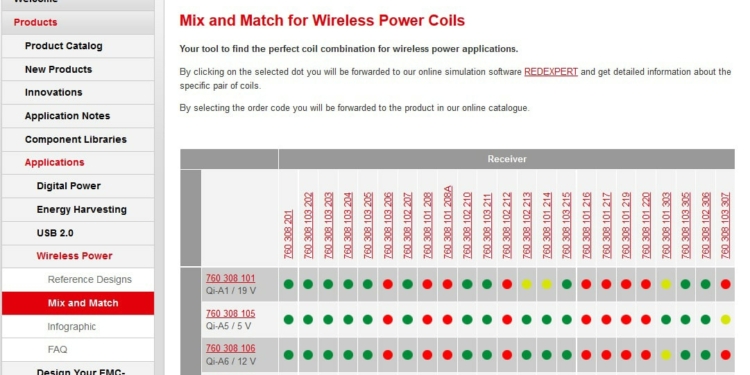source: Würth Elektronik eiSos news
Waldenburg (Germany), 17 August 2017 – Würth Elektronik eiSos is the provider with the world’s broadest product spectrum of wireless power charging coils. The company places a tool at developers’ disposal which facilitates selection of the appropriate transmitter and receiver coils.
Mix and Match is a free-of-charge offering from Würth Elektronik eiSos. As with REDEXPERT – the world’s most precise AC loss calculator for power chokes – the product specifications accessible for Mix and Match are based on extensive measurements of the electrical response of individual coils in sample applications. As an add-on service, a new Resonant Tank app is now integrated, which represents the resonance circuit and from which the developer can view the circuitry and coupling for the selected coils.
The WE-WPCC (Wireless Power Charging Coil) product group offers a wide range of coils for the most diverse wireless power applications – from consumer electronics and industrial applications through to medical technology. Some combinations of transmitter and receiver coils match perfectly, some only with compromises and then there are combinations which have to be advised against, because the coil areas may be in the wrong ratio, for instance.
“A common misconception is that all coils can be combined together arbitrarily according to the Qi standard”, explains Cem Som, Division Manager Wireless Power Transfer at Würth Elektronik eiSos. “We make the developer’s work easier by evaluating all coils and their combinations. Now we provide our customers with Mix and Match, a tool with which every developer would be able to find the right coils for his application. We save him the time and effort from performing his own measurements, because here he finds measurement curves (on permeability, for example), or on the thermal behavior of the coils and can try them out in the Resonant Tank app.”
Empirical values
The extensive measurement series behind the new Mix and Match tool for the coil combinations used in wireless power transmission are a service with which Würth Elektronik eiSos saves its customers time and costs. The background: Calculations on the basis of specifications cannot predict all aspects of coil response and have to be confirmed in tests. For its own wireless power product portfolio, Würth Elektronik eiSos can relieve its customers of this step. The free online tool Mix and Match has been nominated by the editorial office of Design & Elektronik magazine for the award of “Innovator of the Year 2017” in the field of passive components.

































